How Mcuh To Service A Good Watch
Mechanical Movements
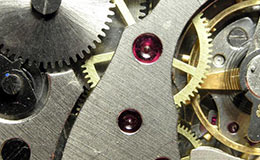
Mechanical watch movements - whether an automatic current of air or a transmission wind - are comprised of pocket-size gears, miniature screws and cardboard springs. To combine all these miniscule pieces, and create a working, accurate sentry is an amazing feat to begin with.
Mechanical wristwatches, specially modern ones with jeweled movements, can terminal forever with the right intendance. They tin, as well, be brought dorsum to life if in reasonable condition.
Accurateness of Mechanical Wristwatches - What to Expect
In the earth of mechanics, anything assembled of modest parts which are capable of maintaining 99% accuracy would be considered a top-tiered piece of machinery. To put things in perspective, if a watch is only 99.ix% authentic it would be off by 1 minute and 27 seconds per solar day, which is unacceptable in the luxury watch globe.
Accurateness is dependant on a few variables, such equally:
- Position: Due to gravity a sentry will proceeds or loose more time if laid to residue in a unmarried position. The balance wheel has been adjusted to compensate for losses and gains in unlike positions. An adjusted scout should perform overall within the specification when worn throughout the mean solar day. If yous remove the watch at night y'all may want to discover the optimum position that will recoup for drift during wear.
Watches are typically adjusted to betwixt two - viii positions:
- Dial Upwards
- Crown Down
- Dial Down
- Crown Left
- Crown Up
- Crown Correct
- Half-way position crown up
- One-half-way position crown down
- Temperature:
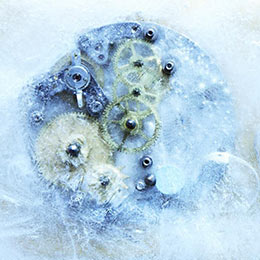 The environment may accept an impact on how accurate the watch operates. Temperature changes expand and contract many of the parts, changing the dimension and shapes - especially the balance bike and hairspring. In modern watches most materials and designs are able to compensate for the changes and maintain a consistent rate. This is mostly not a trouble unless the watch is constantly in farthermost weather environments and is corrected by a very simple regulation.
The environment may accept an impact on how accurate the watch operates. Temperature changes expand and contract many of the parts, changing the dimension and shapes - especially the balance bike and hairspring. In modern watches most materials and designs are able to compensate for the changes and maintain a consistent rate. This is mostly not a trouble unless the watch is constantly in farthermost weather environments and is corrected by a very simple regulation.The standard acceptable accuracy of mechanical wristwatches is every bit follows:
Mod Mechanical not-COSC Certified watch Worst Case Scenario +/-x seconds per solar day 99.988% accuracy Typical +/-5 seconds per day 99.994% accurateness Excellent +/-3 seconds per day 99.996% accurateness Modern Mechanical COSC Certified watch Worst Case Scenario +6/-4 seconds per day 99.994% accuracy Typical +/-3 seconds per mean solar day 99.996% accurateness Excellent +/-1 seconds per solar day 99.998% accuracy
Information technology is important to sympathise that a fresh sentry off the shelf may demand a break-in period of a month or so. This allows the watch to discover its beat out and distribute the lubricants evenly. If yous find the watch not to be equally accurate as yous would expect after the break-in catamenia, there are generally two courses of activity to increase accuracy - both existence minor in nature, simply crave competent watchmakers to perform:
- Regulation: This is for a lookout that runs consistently too fast or too slow - the keyword beingness "consistent". The solution would exist to regulate the beat rate accordingly. This is a very simple and relatively quick process achieved by turning a screw. With the advisable time-measuring machinery a qualified watchmaker can achieve this in a matter of minutes. This procedure is probably one of the most mutual tasks for a watchmaker.
- Adjustment: This is for a watch that is fast or slow or does not accept a consistent rate, especially in different positions. The balance wheel needs to be adjusted to compensate for the different positions. Although this too is a elementary procedure, it does require a piffling more fourth dimension to correct equally each position needs to be monitored and adjusted.
Maintenance and Frequency of Service
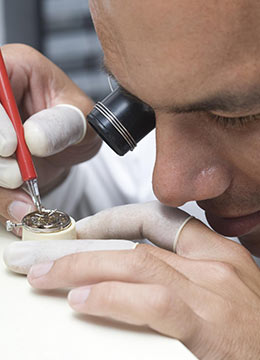
A mechanical wristwatch is comprised of small gears, miniature screws and paper-thin springs - as with whatsoever mechanical instruments that have constantly moving parts, a mechanical watch requires periodic maintenance.
Every bit a watch ages the lubricants start to break down and the gears shift ever so slightly, and the accuracy of the spotter will turn down likewise. The accuracy may exist compensated by performing a couple of regulations (come across above) over the form of a few years. However, ultimately a complete overhaul will be required. At that place are a few methods of thought to the frequency of service. Some say that a service should exist done every 2-3 years as the manufacturer suggests. Others subscribe to the "if it ain't broke, don't fix it" dominion and will but send information technology in to the manufacturer once the lookout stops working - which could be many years. Nosotros propose a middle footing, the lookout man should exist sent in every 5 years - or sooner if you lot notice something amiss. Waiting longer than 5 years to ship it in will result in undue stress wearing out different parts, ultimately costing more than to replace those components. A consummate overhaul entails disassembling the motion, inspecting each component, replacing any damaged components, cleaning each office, lubricating, reassembling, adjusting and regulating the motion.
The cost for a complete overhaul could kickoff at roughly $250 for a elementary watch, going upwardly to $500 for a chronograph and into the thousands for a highly complicated picket.
A typical maintenance requires the scout to be opened, the movement dismantled, and each component cleaned and lubricated. The movement is and then reassembled, regulated, the gaskets changed, and finally, tested.
Learn more well-nigh water resistance.
A Few Notes About Accurateness
Magnetism: 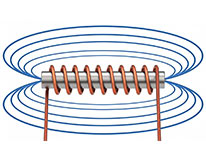 If a watch all of a sudden begins running extremely fast (xx+ seconds per solar day to hours fast per day) information technology is usually an indication that the hairspring coils are magnetized, causing the coils to stick together. This shortens the rotation of the balance cycle and increases the beat rate extremely. Correcting this is one of the simplest tasks for a watch maker. The watch need not be opened (only in farthermost cases) it is passed through a demagnetizing machine and is set up to get again. Magnetism can also cause a watch to stop or run slow; however, by and large the sentry will run fast.
If a watch all of a sudden begins running extremely fast (xx+ seconds per solar day to hours fast per day) information technology is usually an indication that the hairspring coils are magnetized, causing the coils to stick together. This shortens the rotation of the balance cycle and increases the beat rate extremely. Correcting this is one of the simplest tasks for a watch maker. The watch need not be opened (only in farthermost cases) it is passed through a demagnetizing machine and is set up to get again. Magnetism can also cause a watch to stop or run slow; however, by and large the sentry will run fast.
Tangled Coils: This could be acquired by a small-scale jolt to the movement. Although this is less likely than magnetism it is nevertheless a common cause of a watch running extremely fast. The coils are entangled, and this shortens the rotation of the balance bike and significantly increases the beat charge per unit. The expert news is that the fix is fairly simple for a qualified watchmaker to accomplish.
Overall Poor Operation: This is rare on a new watch and will generally be the case of a lookout that is 4-5 years quondam. If the watch runs tedious and cannot be corrected by a regulation, does not maintain a power reserve, stops working while on your wrist - it may signify a deeper upshot, where the skills of an proficient watchmaker are required to pin-point and correct the trouble. The most farthermost resolution is to have the scout completely overhauled. We more often than not recommend sending the lookout man back to the respective company for a job every bit such.
Quartz/Battery-Operated Watches
What is a Quartz lookout?
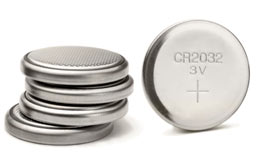
Quartz timepieces utilise the quartz crystals to provide a very authentic resonator which gives a constant electronic signal for timekeeping purposes. Quartz crystals are piezoelectric, which means that they generate an electrical accuse when mechanical pressure is practical to them. They also vibrate if an electrical charge is applied to them. The frequency of this vibration is a function of the cutting and shape of the crystal. Quartz crystals can be cut at a consequent size and shape to vibrate at thousands of times per 2nd, making them extremely stable resonators for keeping very accurate time.
Accurateness:
Modern quartz/battery operated watches are generally more consistently accurate than mechanical wristwatches. Quartz watches are typically accurate to +/-1 2nd per day. Unlike mechanical wristwatches, where accuracy is dependant upon a multifariousness of factors such equally gravity, tolerances and lubricants, quartz watches will continue a consistent time to whatever the original accurateness is. However certain environments may crusade quartz watches to lose their accurateness such equally proximity to high magnetic fields such as MRI equipment, doctors' offices with 10-ray equipment, dentist offices, etc.
As most quartz watches easily outperform the COSC requirement for mechanical wristwatches, the COSC created a whole separate set of tests and standards for a quartz motility requiring the watch to stay accurate to an amazing 0.02 seconds per day!
Every bit the price of the COSC test is high, most companies choose not to certify their watches, equally this would increase the cost of the watch drastically. However, there are a few exceptions such as Breitling quartz watches.
Following is what you can expect in terms of accurateness from quartz watches:
| Modern Quartz (battery) Operated not-COSC Certified sentinel | ||
|---|---|---|
| Worst Case Scenario | +/-2 seconds per mean solar day | 99.997% accuracy |
| Typical | +/-1 seconds per day | 99.998% accuracy |
| Excellent | +/-0.five seconds per 24-hour interval | 99.999% accuracy |
| Modern Quartz (battery) Operated COSC Certified spotter | ||
|---|---|---|
| Worst Case Scenario | +/-0.02 seconds per 24-hour interval | 99.99998% accurateness |
| Typical | +/-0.02 seconds per solar day | 99.99998% |
| Excellent | +/-0.00 seconds per twenty-four hour period | 100% accuracy |
Other pros of quartz watches:
- Servicing is less expensive than a mechanical wristwatch. Equally there are only a few gears for the drive train (manus, minutes and seconds) almost quartz watches crave a less frequent and less entailed servicing. General servicing will consist of a cleaning, lubricating the few gears, replacing the battery, changing the gaskets and water resistance testing.
- In that location is no need to brand sure the watch is wound, which means less attention demand be focused on the lookout.
Our recommendations:
- Have your lookout man h2o tested once a yr. Learn more almost water resistance.
- Ship the watch to the respective manufacturer every other bombardment modify for a complete service.
- When having the battery changed, make sure you detect a watchmaker that has the capability to open up, seal and test the scout. Generally, you can find such watchmakers affiliated with or at a local authorized dealer for fine brand name watches (not necessarily your make, but a make of equivalent condition).
How Mcuh To Service A Good Watch,
Source: https://www.prestigetime.com/page.php?accuracy
Posted by: kwonfordlbeatink.blogspot.com


0 Response to "How Mcuh To Service A Good Watch"
Post a Comment